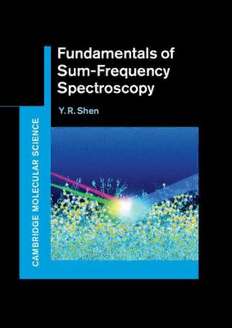Table Of ContentFUNDAMENTALS OF SUM-FREQUENCY SPECTROSCOPY
The first book on the topic, and written by the founder of the technique, this
comprehensive resource provides a detailed overview of sum-frequency spectroscopy, its
fundamental principles, and the wide range of applications for surfaces, interfaces, and
bulk.
Beginning with an overview of the historical context, and introductions to the basic
theory of nonlinear optics and surface sum-frequency generation, topics covered include
discussion of different experimental arrangements adopted by researchers, notes on proper
data analysis, an up-to-date survey commenting on the wide range of successful
applications of the tool, and a valuable insight into current unsolved problems and
potential areas to be explored in the future.
With the addition of chapter appendices that offer the opportunity for more in-depth
theoretical discussion, this is an essential resource that integrates all aspects of the subject
and is ideal for anyone using, or interested in using, sum-frequency spectroscopy.
Y.R. SHEN is responsible for the development of second harmonic and sum-frequency
generation spectroscopy into viable tools for surface and interface studies. He has been on
the faculty of the physics department of the University of California at Berkeley since
1964 and has received many awards, including the Charles Hard Townes Award from the
OSA, the Arthur L. Schawlow Prize and the Frank Isakson Prize from the APS, and the
Max Planck Research Award. He is also a distinguished professor at Fudan University in
Shanghai and an elected member of the US National Academy of Sciences, the American
Academy of Arts and Sciences, the Chinese Academy of Sciences, and Academia Sinica.
CAMBRIDGE MOLECULAR SCIENCE
As we move further into the twenty-first century, chemistry is positioning itself as the
central science. Its subject matter, atoms and the bonds between them, is now central to so
many of the life sciences on the one hand, as biological chemistry brings the subject to the
atomic level, and to condensed matter and molecular physics on the other. Developments
in quantum chemistry and in statistical mechanics have also created a fruitful overlap with
mathematics and theoretical physics. Consequently, boundaries between chemistry and
other traditional sciences are fading and the term Molecular Science now describes this
vibrant area of research.
Molecular science has made giant strides in recent years. Bolstered both by instrumental
and theoretical developments, it covers the temporal scale down to femtoseconds, a time
scale sufficient to define atomic dynamics with precision, and the spatial scale down to a
small fraction of an Angstrom. This has led to a very sophisticated level of understanding
of the properties of small molecule systems, but there has also been a remarkable series of
developments in more complex systems. These include: protein engineering; surfaces and
interfaces; polymers; colloids; and biophysical chemistry. This series provides a vehicle
for the publication of advanced textbooks and monographs introducing and reviewing
these exciting developments.
Series editors
Professor Richard Saykally University of California at Berkeley
Professor Ahmed Zewail California Institute of Technology
Professor David King University of Cambridge
FUNDAMENTALS OF SUM-
FREQUENCY SPECTROSCOPY
Y. R. Shen
University of California at Berkeley
University Printing House, Cambridge CB2 8BS, United Kingdom
Cambridge University Press is part of the University of Cambridge.
It furthers the University’s mission by disseminating knowledge in the pursuit of education, learning, and
research at the highest international levels of excellence.
www.cambridge.org
Information on this title: www.cambridge.org/9781107098848
© Y.R. Shen 2016
This publication is in copyright. Subject to statutory exception and to the provisions of relevant collective licensing
agreements, no reproduction of any part may take place without the written permission of Cambridge University
Press.
First published 2016
Printed in the United Kingdom by TJ International Ltd. Padstow Cornwall
A catalogue record for this publication is available from the British Library
Library of Congress Cataloguing in Publication Data
Names: Shen, Y. R., author.
Title: Fundamentals of sum-frequency spectroscopy / Y.R. Shen, University of California, Berkeley.
Other titles: Cambridge molecular science series.
Description: Cambridge, United Kingdom ; New York, NY : Cambridge University Press, [2016] | ©2015 |
Series: Cambridge molecular science | Includes bibliographical references and index.
Identifiers: LCCN 2015048473| ISBN 9781107098848 (Hardback ; alk. paper) | ISBN 1107098848 (Hardback
; alk. paper)
Subjects: LCSH: Laser spectroscopy. | Nonlinear optics. | Nonlinear optical spectroscopy. | Second harmonic
generation. | Surface chemistry.
Classification: LCC QC454.L3 S53 2016 | DDC 535.8/4–dc23 LC record available at
http://lccn.loc.gov/2015048473
ISBN 978-1-107-09884-8 Hardback
Cambridge University Press has no responsibility for the persistence or accuracy of URLs for external or third-party
internet websites referred to in this publication, and does not guarantee that any content on such websites is, or will
remain, accurate or appropriate.
To Hsiaolin Kai, Pearl, and Alex
Contents
Preface
1 Historical perspective
1.1. Early development of second-harmonic generation as a surface probe
1.2. Early development of sum-frequency spectroscopy for surface studies
1.3. Maturing of SHG and SFG for surface studies
1.4. Prospects
2 Basics of nonlinear optics
2.1. Maxwell’s equations in a medium
2.2. Linear and second-order nonlinear responses
2.3. Multipole expansion of nonlinear polarization
2.4. Structural symmetry of nonlinear susceptibilities
2.5. Nonlinear susceptibilities versus nonlinear polarizabilities
2.6. Microscopic expression of nonlinear polarizabilities
2.7. Summary
Appendix: Multipole expansion of nonlinear polarization and definition of
electric-dipole and electric-quadrupole nonlinear susceptibilities
3 Basic theory for surface sum-frequency generation
3.1. General description
3.2. Sum-frequency generation from an interfacial system with two semi-
infinite bulk media
3.3. Sum-frequency radiation from a polarization sheet
3.4. Bulk contribution to sum-frequency generation
3.5. Sum-frequency generation from both surface and bulk
3.6. Surface and bulk nonlinear susceptibilities
3.7. Surface versus bulk contribution
3.8. Sum-frequency generation for material characterization
3.9. Summary
Appendices

